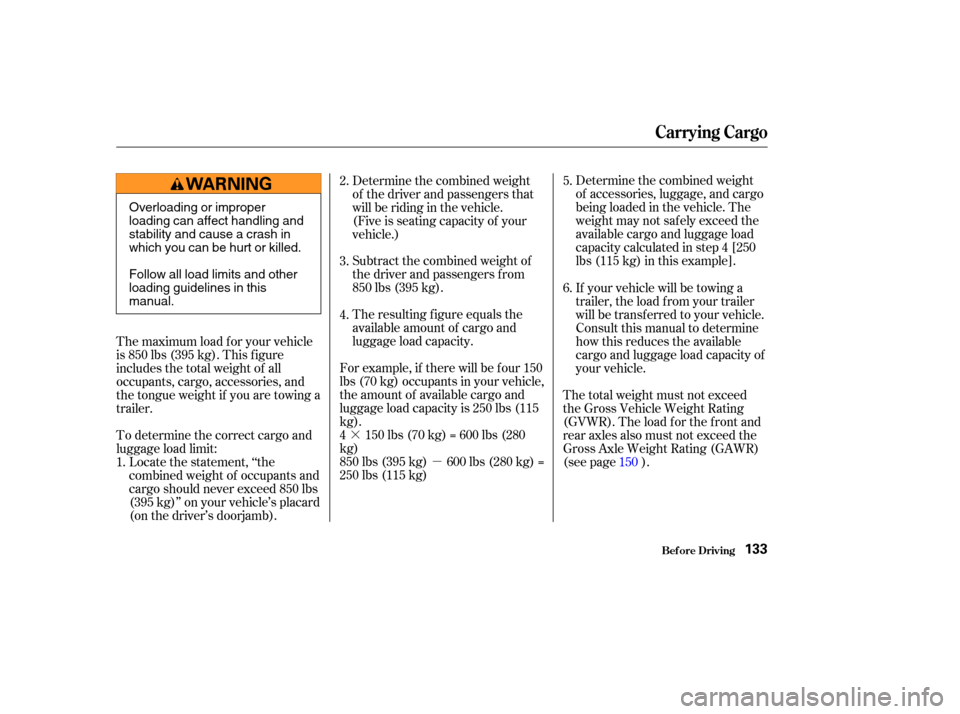Page 129 of 256

Park with the driver’s side closest
to the gas pump.
Open the f uel f ill door by pulling
on the handle located under the
lower lef t corner of the dashboard.Screw the f uel f ill cap back on
until it clicks at least three times.
If you do not properly tighten the
cap, the Malfunction Indicator
Lampmaycomeon(seepage
).
Push the f uel f ill door closed until
it latches. even though the tank is not f ull,
there may be a problem with your
vehicle’s fuel vapor recovery
system. The system helps keep
f uel vapors f rom going into the
atmosphere. Consult your dealer.
Stop f illing the tank af ter the f uel
nozzle automatically clicks of f . Do
not try to ‘‘top off’’ the tank. Leave
some room f or the f uel to expand
with temperature changes. Remove the f uel f ill cap slowly.
You may hear a hissing sound as
pressure inside the tank escapes.
Place the cap in the holder on the
fuel fill door.
1.
2.
3.
4.5.
6.
214
If the f uel nozzle keeps clicking of f
Service Station Procedure
Bef ore Driving
Fueling
125
Pull
Gasoline is highly flammable
and explosive. You can be
burned or seriously injured
when handling fuel.
Stop the engine and keep
heat, sparks, and flames
away.
Handle fuel only outdoors.
Wipe up spills immediately.
Page 133 of 256
Always maintain your vehicle
according to the maintenance
schedule. See(see page
).
an underinf lated tire
causes more ‘‘rolling resistance,’’
which uses f uel.
The build-up of snow or mud on
your vehicle’s underside adds
weight and rolling resistance.
Frequent cleaning helps your f uel
mileage and reduces the chance of
corrosion.
Drive moderately. Rapid
acceleration, abrupt cornering and
hard braking use more f uel.
Always drive in the highest gear
possible. The air conditioning puts an extra
load on the engine which makes it
usemorefuel.Usethefresh-air
ventilation when possible. Combine several short trips into
one. Try to maintain a constant speed.
Everytimeyouslowdownand
speed up, your vehicle uses extra
fuel.Usethecruisecontrolwhen
appropriate.
167
For example,
Fuel Economy
Bef ore Driving
Improving Fuel Economy
Owner’s
Maintenance Checks
129
Page 137 of 256

�·�µ Determine the combined weight
of accessories, luggage, and cargo
beingloadedinthevehicle.The
weight may not saf ely exceed the
available cargo and luggage load
capacity calculated in step 4 [250
lbs(115kg)inthisexample].
The resulting f igure equals the
available amount of cargo and
luggage load capacity. Subtract the combined weight of
the driver and passengers f rom
850 lbs (395 kg). Determine the combined weight
of the driver and passengers that
will be riding in the vehicle.
(Five is seating capacity of your
vehicle.)
For example, if there will be f our 150
lbs (70 kg) occupants in your vehicle,
the amount of available cargo and
luggage load capacity is 250 lbs (115
kg).
4 150 lbs (70 kg) = 600 lbs (280
kg)
850 lbs (395 kg) 600 lbs (280 kg) =
250 lbs (115 kg) If your vehicle will be towing a
trailer, the load f rom your trailer
will be transf erred to your vehicle.
Consult this manual to determine
how this reduces the available
cargo and luggage load capacity of
your vehicle.
The total weight must not exceed
theGrossVehicleWeightRating
(GVWR). The load f or the f ront and
rear axles also must not exceed the
Gross Axle Weight Rating (GAWR)
(see page ).
The maximum load f or your vehicle
is 850 lbs (395 kg). This f igure
includes the total weight of all
occupants, cargo, accessories, and
the tongue weight if you are towing a
trailer.
To determine the correct cargo and
luggage load limit:
Locate the statement, ‘‘the
combined weight of occupants and
cargo should never exceed 850 lbs
(395 kg)’’ on your vehicle’s placard
(on the driver’s doorjamb).
1. 2.
3.
4.
5.
6.
150
Carrying Cargo
Bef ore Driving133
Overloading or improper
loading can affect handling and
stability and cause a crash in
which you can be hurt or killed.
Follow all load limits and other
loading guidelines in this
manual.
Page 139 of 256

This section gives you tips on
starting the engine under various
conditions, and how to operate the
5-speed manual and automatic
transmissions. It also includes
important inf ormation on parking
your vehicle, the braking system,
and f acts you need if you are plan-
ning to tow a trailer or drive off-
highway.........................
Driving Guidelines .136
........................
Preparing to Drive .137
.......................
Starting the Engine .138
....
5-speed Manual Transmission . 139
..............
Automatic Transmission . 141
..................................
Parking Tips .146
.............................
Braking System .147
...............
Anti-lock Brakes (ABS) . 148
.................
Towing Weight Limits . 150
...........................
Towing a Trailer .152
......................
Trailer Driving Tips .155
Towing Your Vehicle Behind a ................................
Motorhome .157
Of f -Highway Driving ..................................
Guidelines .159
Driving
Driving135
Page 140 of 256

Your Honda has a higher ground
clearance that allows you to travel
over bumps, obstacles, and rough
terrain. It also provides good
visibility so you can anticipate
problems earlier.
Because your vehicle rides higher
of f the ground, it has a high center
of gravity that can cause it to roll
over if you make abrupt turns. Utility
vehicles have a signif icantly higher
roll over rate than other types of
vehicles.
To prevent rollovers or loss of
control:Take corners at slower speeds
than you would with a passenger
vehicle.
Avoid sharp turns and abrupt
maneuvers whenever possible. Do not carry heavy cargo on the
roof . Do not modif y your vehicle in any
way that would raise the center of
gravity.
Your Honda is equipped with a f our-
wheel drive (4WD) system. When
the system senses a loss of front-
wheel traction, it automatically
transf ers some power to the rear
wheels. This gives you better
traction and mobility.
You still need to exercise the same
care when accelerating, steering, and
brakingthatyouwouldinatwo-
wheel drive vehicle.Four-wheel Drive Models
See page f or additional guidelinesf or driving of f -highway. 159
Driving Guidelines
Driving136
Page 141 of 256
Check that any items you may be
carrying with you inside are stored
properly or f astened down
securely. Visually check the tires. If a tire
looks low, use a gauge to check its
pressure. Check that the hood, tailgate and
hatch glass are f ully closed. Make sure all windows, mirrors,
and outside lights are clean and
unobstructed. Remove f rost, snow,
or ice.
Youshoulddothefollowingchecks
and adjustments bef ore you drive
your vehicle.
Check the seat adjustment (see
page ).
Check the adjustment of the
inside and outside mirrors (see
page ).
Check the steering wheel
adjustment (see page ).Make sure the doors and tailgate
are securely closed and locked.
Fasten your seat belt. Check that
your passengers have f astened
their seat belts (see page ).
When you start the engine, check
the gauges and indicator lights in
the instrument panel (see page
).
1.
2.
3.
4. 5.
6.
7.
8.
9.
10.
77
89 68 15
55
Driving Guidelines
Driving
Preparing to Drive
137
Page 144 of 256
Drive in the highest gear that lets
the engine run and accelerate
smoothly. This will give you the best
f uel economy and ef f ective emis-
sions control. The f ollowing shif t
points are recommended:Normal acceleration15 mph (24 km/h)
25 mph (40 km/h)
40 mph (64 km/h)
48 mph (77 km/h)
Shif t up
1st to 2nd
2nd to 3rd 3rd to 4th4th to 5th If you exceed the maximum speed
f or the gear you are in, the engine
speed will enter into the tachometer’s
red zone. If this occurs, you may f eel
the engine cut in and out. This is
caused by a limiter in the engine’s
computer controls. The engine will
run normally when you reduce the
RPM below the red zone.
Bef ore downshif ting, make sure the
engine will not go into the
tachometer’s red zone.
Recommended Shif t Points Engine Speed L imiter
5-speed Manual T ransmission
Driving140
Page 147 of 256
�µ
�µ Use Neutral if you
need to restart a stalled engine, or if
it is necessary to stop brief ly with
the engine idling. Shif t to the Park
position if you need to leave your
vehicle for any reason. Press on the
brake pedal when you are moving
the shift lever from Neutral to
another gear.
Use this position f or
your normal driving. The transmis-
sion automatically selects a suitable
gear f or your speed and acceleration.
You may notice the transmission
shif ting up at higher speeds when
the engine is cold. This helps the
engine warm up f aster. TheOver-drive(O/D)ison
whenever you turn the ignition to
ON (II). Pressing the O/D switch on
the edge of the shif t lever to turn it
of f ; the O/D OFF indicator comes
on.Over-drivecanbeturnedonoroff
only when the ignition switch is in
the ON (II) position and the shif t
lever is in any position.
CONT INUED
Neutral (N)
Drive (D)Over-drive (O/D) Mode
Automatic Transmission
Driving143
OVER-DRIVE OFF INDICATOR